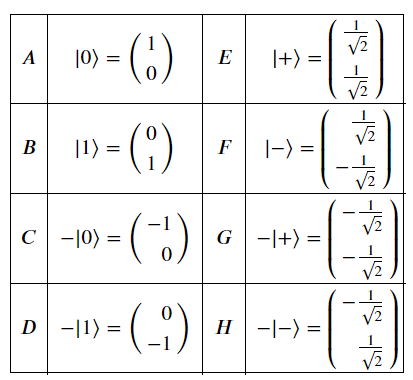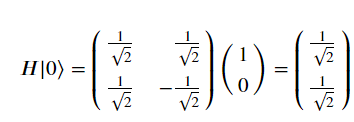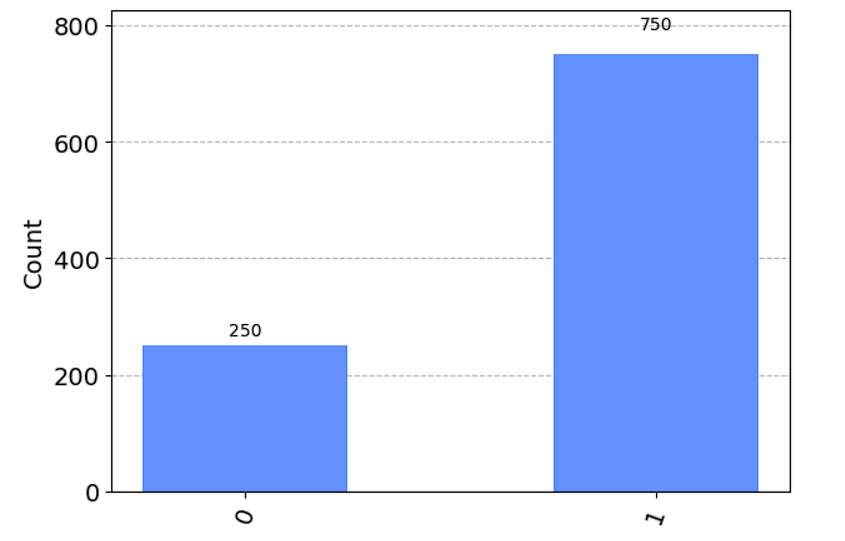量子狀態的表達通常是用Bra–ket notation,下面這是ket notation表示法
量子基本態如下
而量子的疊加態表示法如下
下面則是用qiskit套件實現一個基本的疊加態
# import all necessary objects and methods for quantum circuits
from qiskit import QuantumRegister, ClassicalRegister, QuantumCircuit, execute, Aer
# define a quantum register with one qubit
q = QuantumRegister(1,"qreg")
# define a classical register with one bit
# it stores the measurement result of the quantum part
c = ClassicalRegister(1,"creg")
# define our quantum circuit
qc = QuantumCircuit(q,c)
# apply h-gate (Hadamard: quantum coin-flipping) to the first qubit
qc.h(q[0])
# measure the first qubit, and store the result in the first classical bit
qc.measure(q,c)
# draw the circuit by using matplotlib
qc.draw(output='mpl') # re-run the cell if the figure is not displayed
1.引入套件後
2.創建一個bit的量子暫存器儲存量子位
3.同時建立一個經典暫存器用於接收量子態測量後的資訊
4.之後就是把量子暫存器與經典暫存器結合成一個量子電路
5.並施加一個Hadamard Gate
6.最後就是將量子態的測量結果傳到經典暫存器
7.將量子電路圖畫出
輸出結果如下
Hadamard Gate就是主要用於將基本量子態轉換成疊加態的Operator

前面的程式碼只是用來架構量子電路而已,還無法模擬量子態,接下來就是要用電腦去實際模擬量子操作後的結果
# execute the circuit 10000 times in the local simulator
job = execute(qc,Aer.get_backend('qasm_simulator'),shots=10000)
counts = job.result().get_counts(qc)
print(counts) # print the outcomes
print()
n_zeros = counts['0']
n_ones = counts['1']
print("State 0 is observed with frequency %",100*n_zeros/(n_zeros+n_ones))
print("State 1 is observed with frequency %",100*n_ones/(n_zeros+n_ones))
# we can show the result by using histogram
print()
from qiskit.visualization import plot_histogram
plot_histogram(counts)
{'0': 5116, '1': 4884}
State 0 is observed with frequency % 51.16
State 1 is observed with frequency % 48.84
從結果可以看到,Hadamard Gate可以將量子態疊加至約略0.5|0>+0.5|1>
之所以不是完美的50% 50%是因為實際量子電路的操作會有雜訊,並不完美
若想疊加至其他機率狀態可以用Rotation matrix
from qiskit import QuantumRegister, ClassicalRegister, QuantumCircuit, execute, Aer
from qiskit.visualization import plot_histogram
from math import pi
# we define a quantum circuit with one qubit and one bit
q = QuantumRegister(1) # quantum register with a single qubit
c = ClassicalRegister(1) # classical register with a single bit
qc = QuantumCircuit(q,c) # quantum circuit with quantum and classical registers
# angle of rotation in radian
rotation_angle = 2*pi/3
# rotate the qubit with rotation_angle
qc.ry(2*rotation_angle,q[0])
# measure the qubit
qc.measure(q,c)
# draw the circuit
qc.draw(output='mpl')

# execute the program 1000 times
job = execute(qc,Aer.get_backend('qasm_simulator'),shots=1000)
# print the results
counts = job.result().get_counts(qc)
print(counts)
# draw the histogram
plot_histogram(counts)
{'1': 750, '0': 250}
參考資料:Qworld教材
